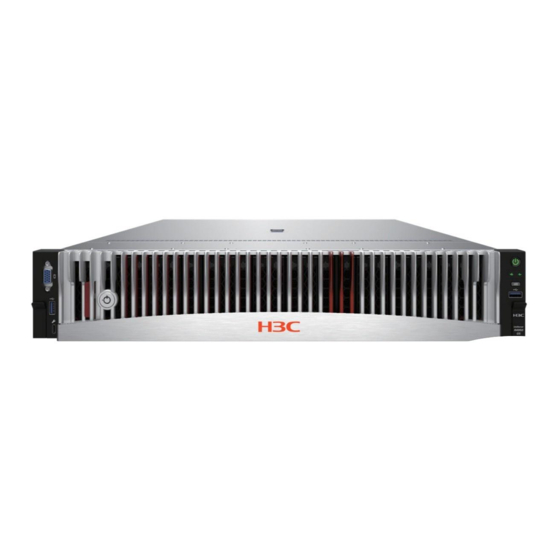
H3C UniServer R4900 G5 Installation, Quick Start
Hide thumbs
Also See for UniServer R4900 G5:
- Operating system installation manual (141 pages) ,
- User manual (401 pages)
Summary of Contents for H3C UniServer R4900 G5
- Page 1 H3C UniServer R4900 G5 Server Processor Installation Quick Start New H3C Technologies Co., Ltd. http://www.h3c.com Document version: 6W100-20210712...
- Page 2 The information in this document is subject to change without notice. All contents in this document, including statements, information, and recommendations, are believed to be accurate, but they are presented without warranty of any kind, express or implied. H3C shall not be liable for technical or editorial errors or omissions contained herein.
- Page 3 Preface This preface includes the following topics about the documentation: • Audience. • Conventions. • Documentation feedback. Audience This documentation is intended for: • Network planners. • Field technical support and servicing engineers. • Server administrators working with the Server. Conventions The following information describes the conventions used in the documentation.
- Page 4 Symbols Convention Description An alert that calls attention to important information that if not understood or followed WARNING! can result in personal injury. An alert that calls attention to important information that if not understood or followed CAUTION: can result in data loss, data corruption, or damage to hardware or software. An alert that calls attention to essential information.
- Page 5 Documentation feedback You can e-mail your comments about product documentation to info@h3c.com. We appreciate your comments.
-
Page 6: Table Of Contents
Content Overview ···························································································································································· 1 Processor kit ······················································································································································ 1 Preparing for installation ···································································································································· 1 Installing the processor ······································································································································ 2 Installing DIMMs················································································································································· 8 Starting the server ·············································································································································· 9... -
Page 7: Overview
The information in this document might differ from your product if it contains custom configuration options or features. The figures in this document are for illustration only. Processor kit The processor kit for an H3C UniServer R4900 G5 server includes the following components: • Processor •... -
Page 8: Installing The Processor
Figure1-1 Removing the access panel Remove the chassis air baffle. As shown in Figure1-2, open the hooks marked by blue trapezoids on the chassis air baffle, and then lift the air baffle up to remove it from the chassis. Figure1-2 Removing the chassis air baffle Installing the processor CAUTION: •... - Page 9 To install the processor: Remove the heatsink protective cover. As shown in Figure1-3, lift the cover straight up and away from the heatsink. CAUTION: When you remove the protective cover from the heatsink, be careful not to touch the thermal grease on the heatsink.
- Page 10 Figure1-4 Installing the processor onto the heatsink Figure1-5 Ejector lever status on the retaining bracket Install the processor onto the retaining bracket. CAUTION: To avoid damage to a processor, always hold the processor by the edges. Never touch the gold contacts on the processor bottom. a.
- Page 11 Figure1-6 Installing the processor onto the retaining bracket d. Open the retention clips on the retaining bracket to lock the processor in place. Figure1-7 Locking the processor Remove the processor socket cover. CAUTION: • Be careful not to touch the pins on the processor socket when you wear ESD gloves to remove the processor socket cover.
- Page 12 As shown in Figure1-8, hold the cover by the tabs at both sides, and lift the cover straight up to remove it from the socket. Keep the cover secure for future use. Figure1-8 Removing the processor socket cover Install the heatsink onto the server. a.
- Page 13 Figure1-10 Holding a heatsink b. Press down the heatsink clips at the four corners to lock the heatsink in place. Figure1-11 Locking the heatsink c. Use a T30 Torx screwdriver to fasten the four captive screws on the heatsink. CAUTION: The screwdriver torque is in the range of 6 to 12 in-lb.
-
Page 14: Installing Dimms
Figure1-12 Fastening the captive screws Installing DIMMs After you install a new processor, install DIMMs for it. For the DIMM installation guidelines, see the server user guide. To install a DIMM: Open the retaining clips of the DIMM slot. Figure1-13 Opening the retaining clips of the DIMM slot... -
Page 15: Starting The Server
Align the notch on the DIMM bottom edge with the key on the DIMM slot. Insert the DIMM into the slot and make sure the retaining clips lock the DIMM in place. The DIMM slot has a structure that prevents misalignment. If you cannot insert the DIMM into the slot easily, the installation might be wrong. - Page 16 a. Place the access panel on top of the server chassis, with the guide pin in the chassis aligned with the pin hole in the locking lever area. b. Close the locking lever. The access panel will automatically slide toward the server front to secure itself into place.
















Need help?
Do you have a question about the UniServer R4900 G5 and is the answer not in the manual?
Questions and answers